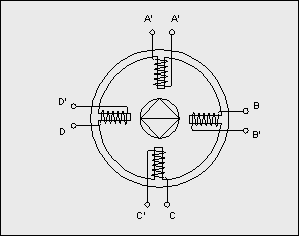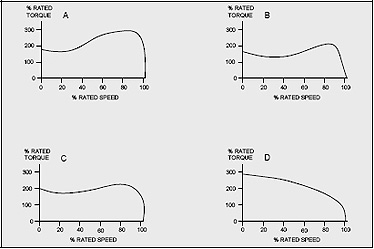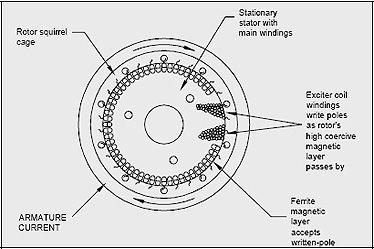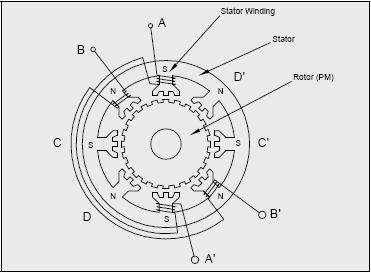Advanced Motors
a. Electronically Commutated Motor (ECM)
An ECM is an electronically commutated permanent magnet DC motor (Figure 6-1).
Electronics provide precisely timed voltages to the coils, and use rotation position sensors for timing.

Figure 6-1: Electronically Commutated Motor (ECM)
The electronic controller can be programmed to vary the torque speed characteristics of the motor for a wide variety of OEM applications such as fans and drives.
Although presently more costly than alternative motor technologies, the higher efficiency and flexible operating characteristics of these motors make them attractive.
An ECM is essentially a brushless DC motor with all speed and torque controls built in (Ref. 3). Typical applications include variable torque drives for fans and pumps, commercial refrigeration, and appliances.
For furnace fans, efficiency can be 20 to 30 percentage points higher than a standard induction motor at full load. However, for constant air circulation ECM's have a definite advantage over standard direct drive blower motors. At half speed, the ECM might consume as little as 10% of the energy of a multi speed blower motor.
For appliances such as washing machines, the ECM can replace the mechanical transmission due to wide range of torque speed characteristics it can produce.
b. Switched Reluctance Motor (SRM)
The advantage of a switched reluctance motor is high torque at low speed, plus a very high speed range (Figure 6-2).

Figure 6-2: Switched Reluctance Motor (SRM)
As with the ECM, electronics provide precisely timed voltages to the coils and use rotation position sensors for timing.
Switched Reluctance motors are used for several hundred thousand premium washing machines per year. No transmission is needed (Ref. 20).
c. Permanent Magnet Motors
New high strength magnetic materials and power electronics have been combined to produce high efficiency variable speed motors ranging from sub fractional to multiple horse power units. Generally these motors/controls are purpose built and are therefore incorporated into OEM products.
d. Other Advanced Motors
Written Pole Motor
Written-Pole motors are special single-phase AC motors which can change the position of magnetic poles while the motor operates (Figure 6-3) (Ref. 4).
In written-pole motors, "permanent" magnet poles are continuously and instantaneously written on a magnetic layer in the rotor by an exciter pole in the stator. The magnetic poles are written to a different spot on the rotor during each revolution when rotor speed changes. This keeps the pole pattern at a constant poles/sec speed.
Most written-pole motors feature an external rotor that spins around an internal stator, opposite that of conventional motors. This inverted structure creates a flywheel effect that allows the machine to ride through brief power disturbances. A 3-phase generator built into the motor provides power to external loads for up to 15 seconds at full load.
The rotor's construction with permanent magnets reduces starting current. Written-pole motors need only one-third the amount of starting current as conventional induction motors.
The written pole motor has found a market in areas with a large number of external power line disturbances brought on by lightening, as they are more immune to such disturbances than power electronics.

Figure 6-3: Written Pole Motor
Linear DC Motors
A linear DC motor, like a rotating DC motor, generates mechanical force by the interaction of current in conductors and magnetic flux provided by permanent rare-earth magnets (Ref. 5).
These motors are constructed of a stator assembly and a slider. The stator assembly contains a laminated steel structure with conductors wound in transverse slots. The slider houses magnets, commutation components and a bearing surface.
Some linear DC motors use a brushless slider that contains an additional set of magnets which activate hall-effect sensors and solid-state switches to commutate the motor windings. This type of motor is capable of precision accuracy to 0.1 micron and does not deteriorate with wear. It can drive loads directly with a wide range of thrust and travel.
Linear AC Motors
Linear AC motors (LIMs) are often used in rail propulsion systems. Stator coils are embedded along the track. Examples of linear AC Motors include the Vancouver Sky Train and the Tomorrowland Transit Authority at Walt Disney World. Speeds of up to 400 km/h are achievable.
Hybrid Motor
The hybrid motor combines the qualities of variable reluctance (VR) and permanent magnet (PM) motors, to achieve desirable features of each (Figure 6-4). They have high detent torque and excellent holding and dynamic torque, and they can operate at high stepping speeds. Normally, they exhibit step angles of 0.9 to 5 degrees. If the phases are energized one at a time in the order indicated, the rotor would rotate in increments of 1.8 degrees. This motor can be driven two phases at a time to yield more torque. It can also be driven to alternate between one and two phase to produce half steps or 0.9 degree increments.

Figure 6-4: Hybrid Motor
Previous: DC Motors | Table of Contents | Next: Motor Selection
Page details
- Date modified: